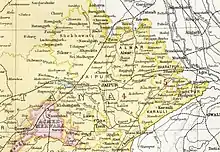Lawa Thikana
Lawa Thikana was a Thikana estate or Thakurat under the Jaipur Residency of the former Rajputana Agency.[1] It was ruled by Naruka Rajputs. It was located very close to Tonk town and included its capital, Lawa, a small town and its surroundings. Lawa is located in the northwestern part of present-day Tonk district of Rajasthan, India.
| Lawa Raj लावा | |||||||||
|---|---|---|---|---|---|---|---|---|---|
| Thakurat of British India | |||||||||
| 1772–1947 | |||||||||
 Lawa State in the Imperial Gazetteer of India | |||||||||
| Capital | Lawa | ||||||||
| Area | |||||||||
• 1901 | 49 km2 (19 sq mi) | ||||||||
| Population | |||||||||
• 1901 | 2671 | ||||||||
| History | |||||||||
| • Type | Principality | ||||||||
| History | |||||||||
• Established | 1772 | ||||||||
• Acceded to India | 1947 | ||||||||
| |||||||||
| Today part of | Rajasthan, India | ||||||||
Lawa estate near Tonk should not be confused with Sardargarh, a Thikana of Udaipur State (Mewar) which had been known as 'Lawa' before 1738.[2][3]
In August 1947, at the time of Independence, Rajasthan included 19 princely state & 3 thikanas (Chiefships) of Neemrana, Lawa & Kushalgarh.[4]
History
Lawa was formerly part of Jaipur State. In 1772 Lawa became a jagir which came under the control of the Marathas through Pindari leader Amir Khan, who would later become the Nawab of Tonk. Lawa became a tributary of Tonk in 1817, when that state was established.[1]
In 1867, following the murder of Thakur Rewut Singh (the uncle of the ruler of Lawa) together with a party of his followers, Lawa was declared a separate Chiefship under the protection of the British Government.[5]
Lawa was one of the Thikanas which were existing at the time of the independence of India and were merged with Rajasthan during the Unification of Rajasthan. It was smallest by area as well as population, and was a completely rural settlement.
Lawa Fort
Although Lawa sustained incalculable myriad of Islamic invasions but the land by the enemy was never occupied, hence no such Islamic or foreign impact is observed in the arts, architecture, culture of this region. This mammoth immersion of Rajput heritage in all its magnificence has civil, military and sacred spreads. The civil area maintained the three, ’administrative block’, 'common living quarters’ and the ladies section which from Mughal days was better known as the Zenana Mahal. The administrative block houses the courts also referred as Dari Khana, meeting place for all major decisions.16th century henceforth every successive ruler of Lawa went on to add more buildings to Barla Mahal (outside mahal) for men, time worn but they still faithfully replicate history. Ravages through time may have altered some of the external features but the rest is the same. The ammunitions and other war material were housed in a safe structure known as the Silehkhana. Though the main fortified ramparts are still there the burjh on the four corners are clearly visible yet it would not be erroneous to address this building as a Chouburjha structure.
Lawa also has chattris (royal cenotaphs) of rulers and warriors who died in wars.
Connections
Raja Udaikaran (1367), the 3rd king of Amber, had his second eldest son Nar Singh among others. Bar Singh who is said to be the eldest son, gave up his right of succession in favour of his brother Nar Singh. Bar Singh received the estates of Jhag and Mauzamabad towns, a few miles south-west of Jaipur. His grandson was Naru, the eponymous founder of Naruka clan.
Thakur Kesri Singh, Thakur of Ladana, eighth in descent from Rao Dasaji (eldest son of Rao Naru), was made the Jagirdar of Ladana by the then ruler of Jaipur. He married and had issue, two sons. Thakur Sawant Singh, succeeded his father and became head of the Ladana Thikana. Thakur Nahar Singh was granted the estate of Lawa by the Ruler of Jaipur in the year 1722.
The name of Lawa & Ladana are often taken together when discussions over Lawa Thikana comes.
Books
Book with name Lawa Raso was composed in Dhundhari language. It was all about the Lawa and Ladana. It has the famous account of Bharat Singh Naruka who cleverly defeated the Pindari leader Amir Khan.
References
- Imperial Gazetteer of India, v. 16, p. 156.
- Imperial Gazetteer of India, v. 22, p. 103. (Sardargarh-Lawa)
- "Sardargarh (Thikana)". Archived from the original on 24 February 2016. Retrieved 27 August 2015.
- "Rajasthan State Formation: Post Independence". RajRAS - Rajasthan RAS. 10 November 2016. Retrieved 6 January 2021.
- A Collection Of Treaties Engagements And Sanads Vol III